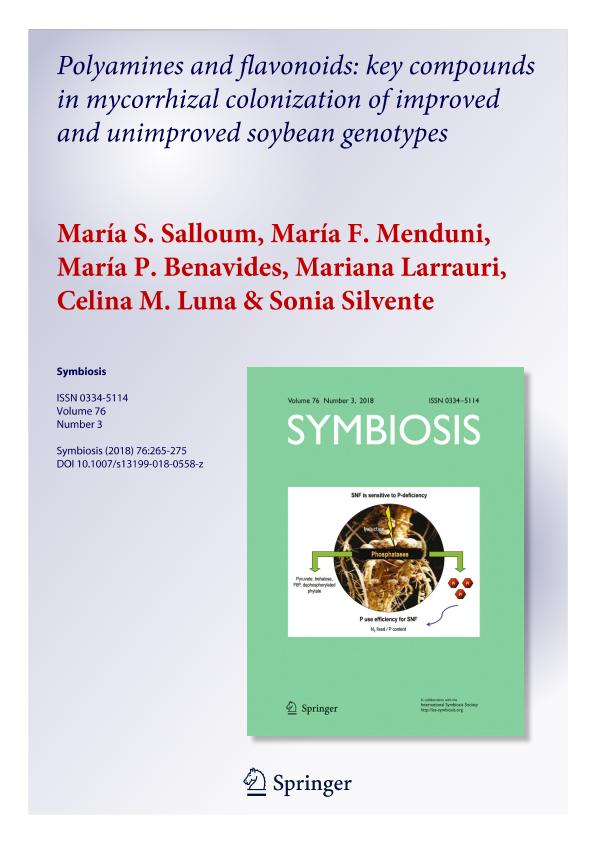Mostrar el registro sencillo del ítem
dc.contributor.author
Salloum, Maria Soraya

dc.contributor.author
Menduni, Maria Florencia

dc.contributor.author
Benavides, Maria Patricia

dc.contributor.author
Larrauri, Mariana

dc.contributor.author
Luna, Celina Mercedes

dc.contributor.author
Silvente, Sonia Teresa

dc.date.available
2020-02-27T17:15:16Z
dc.date.issued
2018-11
dc.identifier.citation
Salloum, Maria Soraya; Menduni, Maria Florencia; Benavides, Maria Patricia; Larrauri, Mariana; Luna, Celina Mercedes; et al.; Polyamines and flavonoids: key compounds in mycorrhizal colonization of improved and unimproved soybean genotypes; Springer; Symbiosis; 76; 3; 11-2018; 265-275
dc.identifier.issn
0334-5114
dc.identifier.uri
http://hdl.handle.net/11336/98515
dc.description.abstract
Modern breeding programs might have caused a reduction in plant responsiveness to arbuscular mycorrhizal fungi (AMF). Flavonoids and polyamines (PAs) are hypothesized to play a role in this symbiosis. We tested the effects of them in AMF roots of improved (I-1) and unimproved (UI-4) soybean genotypes, under the hypothesis that domestication decreased their concentration in roots, affecting AMF colonization, particularly arbuscule formation. After 20 days of treatment, AMF roots of UI-4 genotype had greater amount of total flavonoids/phenols and PAs while in I-1 genotype no differences were observed between roots of mycorrhizal (M) and non mycorrhizal (NM) plants. Exogenous application of flavonoids led to an increase in arbuscules in both genotypes. Improved-1 genotype needed higher levels of flavonoids to reach the percentage of mycorrhization achieved by UI-4 control. In regard to PAs, mycorrhizal plants of both genotypes had higher endogenous concentration than NM plants, however, the highest concentration, especially of putrescine (put) was in UI-4 M genotype. To check the participation of put in symbiosis we used RNAi silencing methodology. Down regulation of the GmADC transcript, involved in put formation, had a profound negative effect on mycorrhizal colonization and also affected the normal development of the plant. By contrast, down regulation of GmDAO, in which ADC transcript was expressed, arbuscule formation was similar to control plant. Our results suggest that mycorrhizal colonization is affected by soybean domestication particularly arbuscule formation and this effect seems to be mediated by the endogenous roots levels of flavonoids and PAs, especially put.
dc.format
application/pdf
dc.language.iso
eng
dc.publisher
Springer

dc.rights
info:eu-repo/semantics/openAccess
dc.rights.uri
https://creativecommons.org/licenses/by-nc-sa/2.5/ar/
dc.subject
ARBUSCULAR MYCORRHIZAL FUNGI (AMF)
dc.subject
FLAVONOIDS
dc.subject
POLYAMINES
dc.subject
IMPROVED AND UNIMPROVED SOYBEAN GENOTYPES
dc.subject.classification
Micología

dc.subject.classification
Ciencias Biológicas

dc.subject.classification
CIENCIAS NATURALES Y EXACTAS

dc.title
Polyamines and flavonoids: key compounds in mycorrhizal colonization of improved and unimproved soybean genotypes
dc.type
info:eu-repo/semantics/article
dc.type
info:ar-repo/semantics/artículo
dc.type
info:eu-repo/semantics/publishedVersion
dc.date.updated
2020-02-19T18:05:29Z
dc.journal.volume
76
dc.journal.number
3
dc.journal.pagination
265-275
dc.journal.pais
Alemania

dc.description.fil
Fil: Salloum, Maria Soraya. Instituto Nacional de Tecnología Agropecuaria. Centro de Investigaciones Agropecuarias. Instituto de Fisiología y Recursos Genéticos Vegetales; Argentina. Consejo Nacional de Investigaciones Científicas y Técnicas; Argentina
dc.description.fil
Fil: Menduni, Maria Florencia. Instituto Nacional de Tecnología Agropecuaria. Centro de Investigaciones Agropecuarias. Instituto de Fisiología y Recursos Genéticos Vegetales; Argentina. Consejo Nacional de Investigaciones Científicas y Técnicas; Argentina
dc.description.fil
Fil: Benavides, Maria Patricia. Consejo Nacional de Investigaciones Científicas y Técnicas. Oficina de Coordinación Administrativa Houssay. Instituto de Química y Físico-Química Biológicas "Prof. Alejandro C. Paladini". Universidad de Buenos Aires. Facultad de Farmacia y Bioquímica. Instituto de Química y Físico-Química Biológicas; Argentina
dc.description.fil
Fil: Larrauri, Mariana. Instituto Nacional de Tecnología Agropecuaria. Centro de Investigaciones Agropecuarias. Instituto de Fisiología y Recursos Genéticos Vegetales; Argentina. Consejo Nacional de Investigaciones Científicas y Técnicas. Centro Científico Tecnológico Conicet - Córdoba. Instituto Multidisciplinario de Biología Vegetal. Universidad Nacional de Córdoba. Facultad de Ciencias Exactas Físicas y Naturales. Instituto Multidisciplinario de Biología Vegetal; Argentina
dc.description.fil
Fil: Luna, Celina Mercedes. Consejo Nacional de Investigaciones Científicas y Técnicas; Argentina. Instituto Nacional de Tecnología Agropecuaria. Centro de Investigaciones Agropecuarias. Instituto de Fisiología y Recursos Genéticos Vegetales; Argentina
dc.description.fil
Fil: Silvente, Sonia Teresa. Universidad Nacional de Chilecito; Argentina
dc.journal.title
Symbiosis

dc.relation.alternativeid
info:eu-repo/semantics/altIdentifier/url/http://link.springer.com/10.1007/s13199-018-0558-z
dc.relation.alternativeid
info:eu-repo/semantics/altIdentifier/doi/https://doi.org/10.1007/s13199-018-0558-z
Archivos asociados
